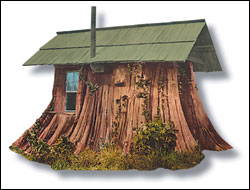I come from a family of curio collectors: My grandfather’s house was filled with incredible objects, from Gold Rush souvenirs to a genuine suit of armor, each carefully numbered. His den had a cabinet full of wonders, including a tarantula and a Wendell Wilkie cigar. My father, a scientist with a specimen-lined laboratory in our basement, made assemblage boxes in the style of Joseph Cornell. One of my sisters coined a term when she was a tot, a word to describe that rush of attraction you feel, say, when finding tiny, precious objects in a small tin box: bulla bulla. Keeping with family tradition, I too have a mania for collecting, expressed through my secondary career as an expert on time capsules, the effort to put the odds and ends of culture into a compact container and bury it for future generations.
Deep Storage, Arsenal of Memory
Henry Gallery
November 5 to January 24
With “Deep Storage, Arsenal of Memory,” the Henry Art Gallery offers an exhibit that will appeal to those who are inveterate collectors and accumulators of stuff. Spread over three galleries, “Deep Storage” is the largest and most ambitious exhibition the Henry has ever hosted. First shown in Germany at Munich’s Haus der Kunst, this scaled-down version appeared last summer at New York’s P.S.1 Center for Contemporary Art. Seattle is its only other stop in the US.
The exhibit explores the impulse to contain, arrange, and exhibit cultural ephemera, whether in a curio cabinet, a collage, a time capsule, or even a museum. Our desire to corral objects and art is a provocative concept in the arts: Some would argue it is the arts. What else is a museum or a theater than a large box of stuff? One definition of art could very well be that which is either put in the box or left out. Little wonder that some contemporary artists consider the acts of containment, storage, collecting, exhibiting, archiving, filing, selecting, and arranging to be legitimate forms of artistic expression in and of themselves.
For some artists, playing with these themes is a way to critique the idea of art itself. “Deep Storage” offers a range of oddball works, from assemblages and archival films, to elaborate found-art sculptures, to pop art classics, many of which contain elements of artistic mischief. One such work is Marcel Duchamp’s Bo-en-valise, in which miniatures of his work are fitted into suitcases. These cases suggest an autobiographical time capsule in which the artist has preserved not only his works, but the very idea of his works. By making little models of his paintings and sculptures, the surrealist not only preserved the concepts of the originals, but created a whole new work from reproductions. He also brilliantly conveyed the unique sense of what makes Duchamp Duchamp: a man whose legacy can fit in a carry-on bag.
Andy Warhol takes the idea of legacy-in-a-box further with his famous Time Capsule series. Warhol scooped up the detritus of his life (or had his assistants do it) and tossed it into dated boxes he called “time capsules.” In essence, he cleaned his messy room occasionally and packed the stuff off for posterity. Some might call it crap from Warhol’s studio floor, but as a body of “work” it suggests that an artist’s identity is as much in the tools and everyday objects he used as in what he painted or sculpted for an audience.
A large installation by German artist Karsten Bott, One of Each, makes this point dramatically. Bott has collected thousands of everyday objects, which he inventories and arranges on the floor in patterns inspired by their function, color, shape, and texture. Bott’s things are carefully stored, labeled, and collected with all the seriousness and reverence a museum curator might accord ancient Greek pottery. Only in this case, the items are baby shoes and bubble gum. Viewers wander through this vast spread of stuff on a raised boardwalk, much as you might wander through an imaginary landscape in a world’s fair pavilion. The items below form a colorful, whimsical quilt and offer an intriguing statement about how much a person’s life is simply an arrangement of things.
Sheryl Conkelton, curator of the Seattle show, says that identity is what “Deep Storage” is all about. “It is about the reassertion of the artist.” In all these works, the artist’s presence is palpable and present even while the very definition of art is being reworked, smashed, or parodied. She says that in these endeavors artists are trying to “take back the significance” of their own work by refusing to give arts scholars and museums the final authority to assign significance to their creations.
However provocative these ideas may be, spending too much time pondering the deeper meaning of “Deep Storage” can be a distraction. The fact is, many of the works in the exhibit and the marvelous catalog that documents it resonate with a deep sense of, well, bulla bulla. French artist Arman’s boxes of old wooden ink blotters and antique telephones create a sculptural trompe l’oeil that reveals how compelling arrangements of like objects can be. American artist Jeanne Silverstone’s minimalist miniature models of artists’ studios appeal to one’s inner child as made-for-adult toys. Man Ray and Christo’s wrapped objects play with the powerful sense of mystery generated by draping an object—or a building—in a blanket.
Silverstone has described such works as the “memento mori of the house of culture.” As such there is much to contemplate in “Deep Storage,” which extends an invitation to dig through a fascinating artistic attic. Given the amount of cultural excavation on display, this is an exhibit that would feel right at home at the Burke.






